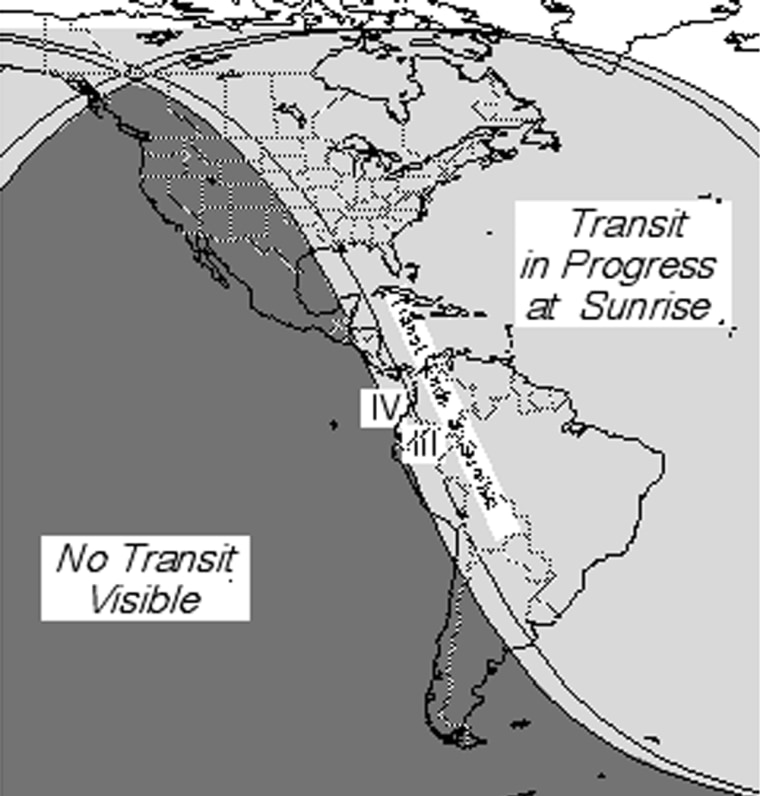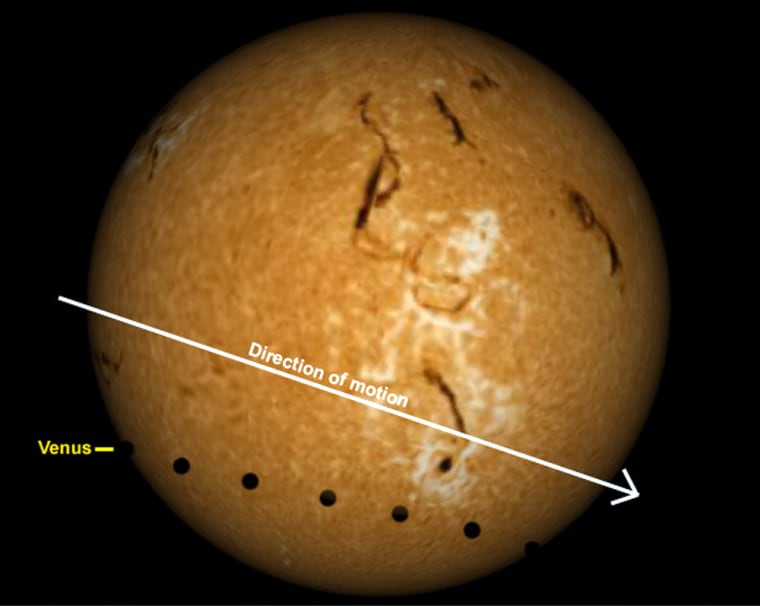Put a big red circle around June 8 on your calendar. On that day, you may have a chance to see a celestial event not witnessed by human eyes in 122 years when Venus crosses in front of the sun.
Venus has been growing brighter and climbing higher into our evening sky lately. It has evolved into an "evening lantern" for those commuting home from work and school.
By the end of May 2004, however, Venus will be rapidly dropping back toward the sun’s vicinity, ultimately to disappear as it makes the transition back into the morning sky. That transition day will be June 8.
Normally, Venus would pass unseen, hidden in the brilliant glare of the sun. But not this time.
For on that Tuesday in June, Venus will make itself evident as a small black spot slowly moving across the solar disk. Portions of the hours-long transit will be visible from many locations around the world, including parts of Europe and America. Some folks will need to make travel plans, however, to see the show.
Rare opportunity
This is among the rarest of astronomical events. In fact, between the years 2000 B.C. and A.D. 4000 there are only 81 Venusian "transits," as astronomers call them.
Only five times have humans recorded the passage of Venus in front of the sun (in 1639, 1761, 1769, 1874 and 1882), although it’s not impossible that a transit of Venus might have once been seen by chance in ancient times, near sunrise or sunset. Possibly on such an occasion, some ancient observer with a keen eye, viewing the sun on an unusually hazy day, might have glimpsed our sister planet's dark image on the solar disk, reporting it as "a dark mark on the sun."
Astronomer Joseph Ashbrook (1918-1980) wrote in "The Astronomical Scrapbook" (Sky Publishing Corporation, 1984): "For those who witness the transit of June 8, 2004, there comes the awesome thought that not a single human being remains alive that observed the last transit of Venus, in December 1882."
Mathematical marvels
There is some neat math involved in Venus transits, all related to the predictability of its orbit, which is closer to the sun than the annual path of Earth.
The circumstances of the transits of Venus repeat themselves with great exactness after a period of 243 years. The intervals between individual transits (in years) currently go as follows: 8 + 121½ + 8 + 105½ = 243. In other words, a pair of transits may occur over a time span of just eight years, but following the second transit, the next will not occur again for more than a century.
Transits of Venus occurred on Dec. 9, 1874 and Dec. 6, 1882. The transit this June is the first one since 1882, but the next will occur 8 years later on June 6, 2012, although this future event will be visible in its entirety only from the Pacific Ocean and the extreme east coasts of Siberia, Japan and Australia (North Americans will see the opening stages before sunset).
Then it will be a long wait once again. On December 11, 2117, Venus will again pass in front of the sun.
Transits do not occur each time Venus passes from our evening to our night sky because things have to be lined up just right.
When a transit occurs, the sun, Venus and Earth are all in a direct line. But Earth and Venus do not orbit in exactly the same plane around the sun, so often each planet is either above or below the location that would allow a transit.
Think of it this way: Place two hoops on the ground to represent the orbits of the planets. Place a tennis ball in the middle as the un. Now lift one portion of one hoop a few inches off the ground. Only where the opposite side of the lifted hoop touches the ground can you imagine a line that connects all three objects.
Locations to watch
On June 8, the entire transit will last just more than six hours and will be visible in some form across approximately three-quarters of our planet.
The beginning will be visible from northern and western portions of Alaska, all of Asia, Indonesia and Australia, the eastern half of Africa and northern and eastern Europe, as well as the northernmost parts of Greenland. The end will be visible over central and western Asia, all of Africa, Europe and Greenland as well as northernmost and eastern sections of North America and northern and eastern parts of South America.

Australians will be able to catch the beginning stages before sunset. Europeans will be able to see most, if not all of the transit, starting at around sunrise with the end coming in the early afternoon with the sun high in the sky. For much of the eastern United States and Canada, the sun will rise with Venus already on the sun’s disk with the transit nearly over.
Unfortunately, those living across the western United States and Canada, as well as Hawaii, will be precluded from seeing any part of this spectacle, as the sun will be below the horizon when it takes place.
Transits of Mercury are more common. One occurred last May. But Mercury transits are difficult to notice because the planet is so small and far away. Venus is closer to Earth and larger.
Venus transits are readily visible without telescopes or binoculars, but proper protection must be employed. Never look directly at the sun, or serious eye damage can result. Viewers should use special, approved filters that can be purchased from reputable dealers of astronomy products. Other tricks can be employed, such as pinhole cameras or simple projection methods, to view the sun indirectly and safely.
When Venus is in transit across the solar disk, the planet appears as a distinct, albeit tiny, round black spot with a diameter just one-thirty-second that of the sun. This size is large enough to perceive with the unaided but properly protected eye.
Space.com and MSNBC.com will provide more detail on the great Venus transit of 2004 in the weeks leading up to the event.
